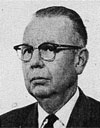Felix Moore
Born:

After earning his bachelor’s degree in mathematics, Felix Moore was trained in statistics and demography as a graduate student at the University of Chicago in the late 1930s. He then began a long career in government service working for the War Department studying morale of the Allied and Axis militaries using quantitative methods. After the war Moore was stationed in occupied Japan to organize a Cabinet Bureau of Statistics and a national census.
Moore’s first exposure to epidemiology came in the United States at the National Center for Health Statistics where he worked with public health officials to develop the Health Information Survey to determine state-wide morbidity in California. This experience led to a position with the National Institutes of Health (NIH) and the newly established National Heart Institute (NHI). Moore established the Biometrics Research Branch of the NHI and began work on the Framingham Heart Study when it was transferred to the Heart Institute in 1949. This launched his involvement with cardiovascular disease epidemiology, an association that would continue for many decades at the University of Michigan. Moore is remembered for his design of the Framingham Study cohort and his analysis of the Cooperative Study on Blood Lipoproteins in the 1950s and analysis of the American Heart Association Pooling Project in the 1960s and 70s. (KR)
Sources
Oral history with Henry Blackburn and Richard Shekelle, August 8, 1989.
Dawber, T. R. The Framingham Study: The Epidemiology of Atherosclerotic Disease. Cambridge: Harvard University Press, 1980.
Geller, Nancy L. “A Conversation with Tavia Gordon.” Statistical Science 12 (1997): 113-118.